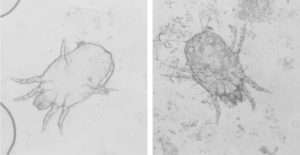Abstract:
Walking dandruff is the common name for a skin condition caused by infestation of a dog’s skin by tiny Cheyletiella mites. These mites burrow through the outer layers of the dog’s skin, causing irritation and mild to severe itchiness as a result of mechanical irritation. Dogs, cats, horses and rabbits can become transiently infested with the Cheyletiella mites that normally populate other hosts. This happens through direct contact between an animal carrying the mites and a member of a different susceptible species (dogs, cats, rabbits or even people). For example, a human can become infested by Cheyletiella yasguri mites as a result of petting an infested dog, which is the normal host for that particular species of mite.
Case 1 : a male patient 34 years of age presented to us with complains of itching off and on in the groins for 1 month. He had taken self medication with topical creams without any improvement. On examination few minute erthytematous papules with excoriations were noticed over the groins & inner thighs. There were no annular lesions suggestive of fungal infection, the genitals were not involved and there was no history of nocturnal itching .He gave history of having pet dog at home. Baseline investigations were within normal limits. On skin scrape for KOH examination revealed the large mite with four pair of legs and prominent accessory mouth parts which terminated in hooks. Diagnosis of Cheyletiella Yasguri was made based on the miscroscopic appearance of the mite. Patient was treated with tab Ivermectol 12 mg with anti pruritic soothing lotion and antihistamine. On follow up 15 days later he showed satisfactory improvement in both itching and lesions.
Case 2: a male patient of 32 years old presented to us with asymptomatic , well defined alopecia patch on the scalp with scaling. His baseline investigations were within normal limits. KOH examination was done from the scalp to rule out tinea capitis which was negative . However we found the mite Cheyletiella yasguri in the same field. He was given necessary treatment for alopecia and ivermectol shampoo for single hairwash.

Discussion
Walking dandruff can be described as a form of mild dermatitis that occurs due to the presence of a mite called Cheyletiellosis on the scalp. These mites, are more commonly found in animals like cats, dogs, rabbits and horses, but can also spread to humans. The motion of the visible mites give the condition its unusual name, as the dandruff seems to walk around the scalp.
Walking dandruff is highly contagious, as Cheyletiellosis mites easily spread from one host to the other. It can be contracted by prolonged personal contact with an infected animal. The entire life cycle of the mite on one host is around 21 days. Once the infected animal is treated, the possibility of transference to humans is eliminated. Because animals do not necessarily show symptoms of the mites the owners do not realise that they are infected. It is noticed as whitish, dandruff like flakes on the hair, which seems to be moving around. Other signs and symptoms of walking dandruff include severe itching and blisters on the scalp, red bumps on the arms, trunk and buttocks. These symptoms usually disappear within a time span of 3 weeks, as people are not the preferred hosts for the mites. However, humans can experience a lot of pain and discomfort because of the mites. therefore walking dandruff should be treated as soon as possible. A number of different have shown to be effective including high dose ivermectin, milbemycin oxime, moxidectin, selamectin, fiprofil and pyrethrin shampoos. Infestations in cats and dogs can be prevented by routine administration of topical antiflea applications on a monthly basis.
References:
- 1.Arther RG. 2009.Mites and lice :biology and control.VCNA Small Amin Pract. 39:1159-712.
- Paradis M, Villeneuve A (August 1988).” Efficacy of Ivermectin against Cheyletiella yasguri infestation in Dog”. Can.Vet.J.29(8):633-635.
- Bakkers, E.J.M; Fain, A. (1972). :Dermatitis in man and in a dog caused by the mite Cheyletiella yasguri Smiley”.British Journal of Dermatology, 87(3):245-247.
- Powell, Ralph F;Palmer, Susan M;Palmer, Charles H; Smith, Edgar B. (1977). “Cheyletiella dermatitis”, International Journal of Dermatology.16(8):679-682.






